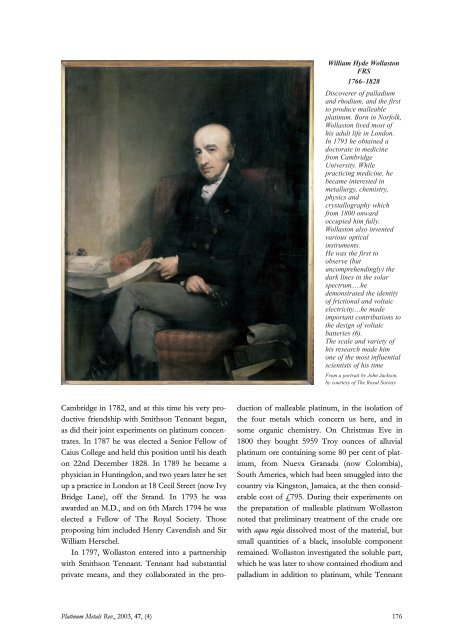Bicentenary of Four Platinum Group Metals - Platinum Metals Review
Bicentenary of Four Platinum Group Metals - Platinum Metals Review
Bicentenary of Four Platinum Group Metals - Platinum Metals Review
You also want an ePaper? Increase the reach of your titles
YUMPU automatically turns print PDFs into web optimized ePapers that Google loves.
William Hyde Wollaston<br />
FRS<br />
1766–1828<br />
Discoverer <strong>of</strong> palladium<br />
and rhodium, and the first<br />
to produce malleable<br />
platinum. Born in Norfolk,<br />
Wollaston lived most <strong>of</strong><br />
his adult life in London.<br />
In 1793 he obtained a<br />
doctorate in medicine<br />
from Cambridge<br />
University. While<br />
practicing medicine, he<br />
became interested in<br />
metallurgy, chemistry,<br />
physics and<br />
crystallography which<br />
from 1800 onward<br />
occupied him fully.<br />
Wollaston also invented<br />
various optical<br />
instruments.<br />
He was the first to<br />
observe (but<br />
uncomprehendingly) the<br />
dark lines in the solar<br />
spectrum.....he<br />
demonstrated the identity<br />
<strong>of</strong> frictional and voltaic<br />
electricity....he made<br />
important contributions to<br />
the design <strong>of</strong> voltaic<br />
batteries (6).<br />
The scale and variety <strong>of</strong><br />
his research made him<br />
one <strong>of</strong> the most influential<br />
scientists <strong>of</strong> his time<br />
From a portrait by John Jackson,<br />
by courtesy <strong>of</strong> The Royal Society<br />
Cambridge in 1782, and at this time his very productive<br />
friendship with Smithson Tennant began,<br />
as did their joint experiments on platinum concentrates.<br />
In 1787 he was elected a Senior Fellow <strong>of</strong><br />
Caius College and held this position until his death<br />
on 22nd December 1828. In 1789 he became a<br />
physician in Huntingdon, and two years later he set<br />
up a practice in London at 18 Cecil Street (now Ivy<br />
Bridge Lane), <strong>of</strong>f the Strand. In 1793 he was<br />
awarded an M.D., and on 6th March 1794 he was<br />
elected a Fellow <strong>of</strong> The Royal Society. Those<br />
proposing him included Henry Cavendish and Sir<br />
William Herschel.<br />
In 1797, Wollaston entered into a partnership<br />
with Smithson Tennant. Tennant had substantial<br />
private means, and they collaborated in the production<br />
<strong>of</strong> malleable platinum, in the isolation <strong>of</strong><br />
the four metals which concern us here, and in<br />
some organic chemistry. On Christmas Eve in<br />
1800 they bought 5959 Troy ounces <strong>of</strong> alluvial<br />
platinum ore containing some 80 per cent <strong>of</strong> platinum,<br />
from Nueva Granada (now Colombia),<br />
South America, which had been smuggled into the<br />
country via Kingston, Jamaica, at the then considerable<br />
cost <strong>of</strong> £795. During their experiments on<br />
the preparation <strong>of</strong> malleable platinum Wollaston<br />
noted that preliminary treatment <strong>of</strong> the crude ore<br />
with aqua regia dissolved most <strong>of</strong> the material, but<br />
small quantities <strong>of</strong> a black, insoluble component<br />
remained. Wollaston investigated the soluble part,<br />
which he was later to show contained rhodium and<br />
palladium in addition to platinum, while Tennant<br />
<strong>Platinum</strong> <strong>Metals</strong> Rev., 2003, 47, (4) 176
















